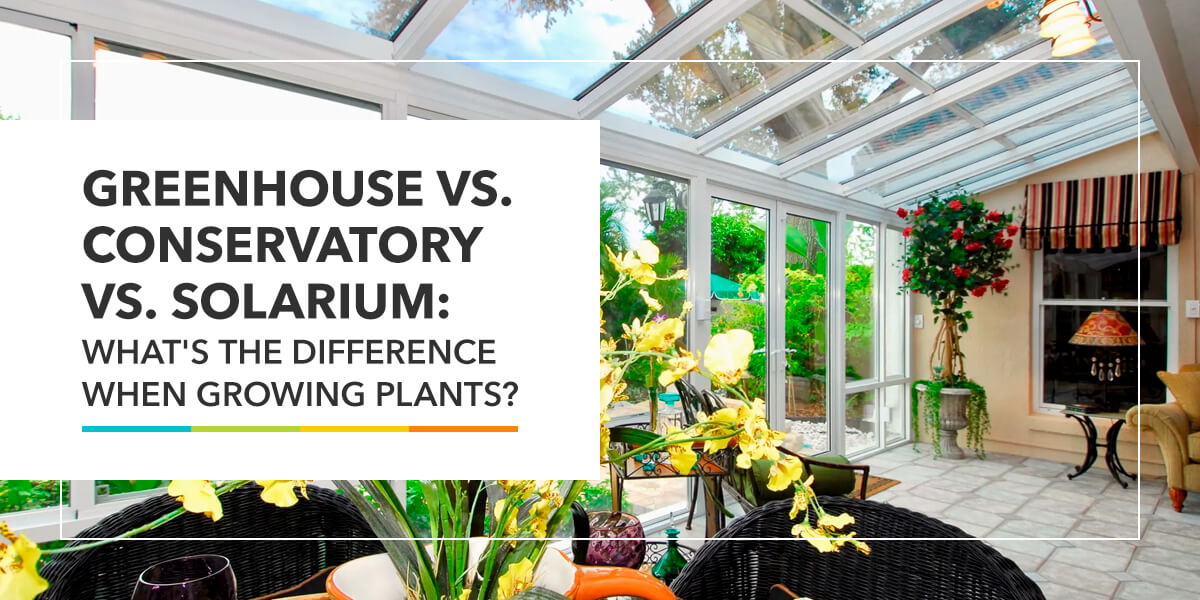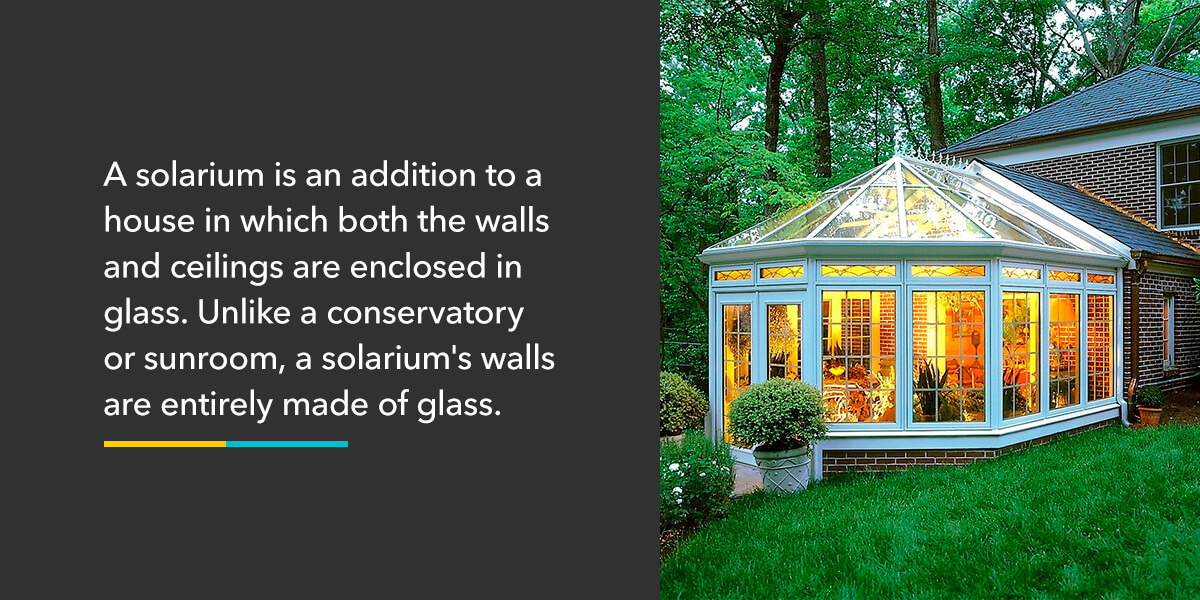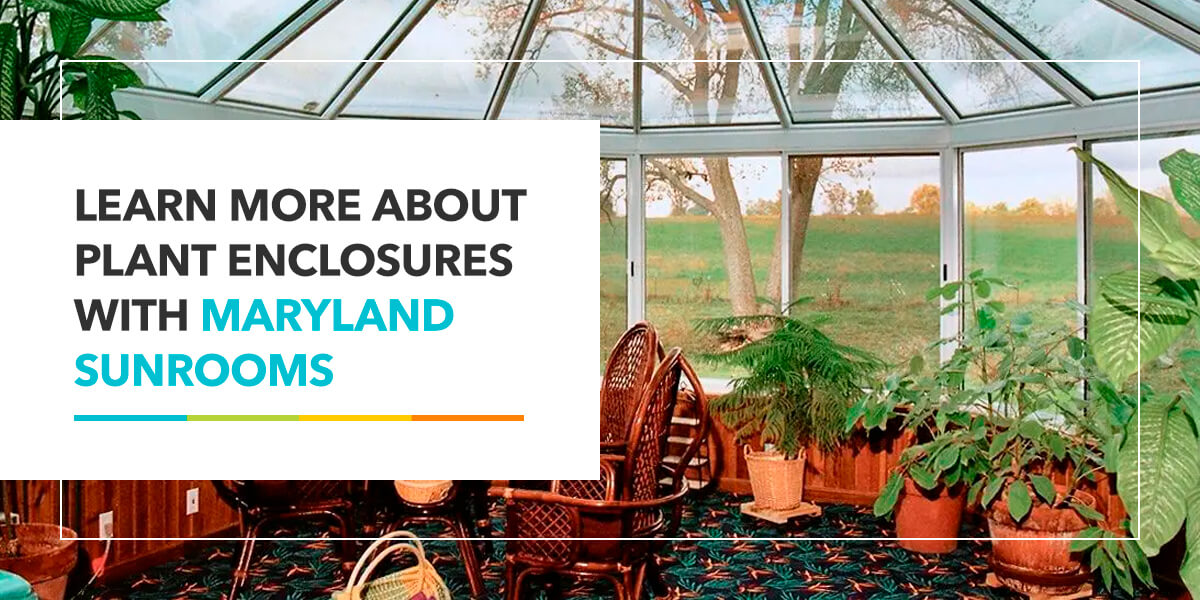If you live in an area like Maryland that sees the changing of seasons, you may already know it can be difficult to tend to a garden year-round. Changing weather can be unpredictable and can damage crops exposed to the elements.
As a homeowner who gardens year-round, consider installing an indoor enclosure to tend to your plants. An indoor enclosure, such as a solarium, greenhouse or conservatory, can offer your plants protection from harsh outdoor elements and predators while still maintaining a visually pleasing appearance for your home.
We’ll walk you through the differences between a solarium, greenhouse and conservatory enclosure. Discover the right addition to keep your plants healthy year round.
What Is a Solarium?
A solarium is an addition to a house in which both the walls and ceilings are enclosed in glass. Unlike a conservatory or sunroom, a solarium’s walls are entirely made of glass. Intended to be used during all four seasons of the year, a solarium has thicker glass than a greenhouse, which allows the sun to warm the space even in colder months.
Benefits of Planting in a Solarium
A solarium is an excellent choice for gardens and plants that require a lot of sunshine but may struggle to survive outdoors in the elements due to changes in weather and predators. A solarium allows all of the natural sunlight of the outdoors inside without most of the negatives of an outdoor space.
Learn More About Our Product Offerings
Downsides of Planting in a Solarium
The major downside of a solarium is the constant maintenance required to keep the structure in good condition. The glass ceiling of a solarium needs to be cleaned regularly. The glass windows must be cleaned often, as well, so their appearance is not fogged or dirty.
What Is a Greenhouse?
A greenhouse is a structure made almost entirely from glass or thick transparent plastic. Its sole purpose is to grow plants in, unlike a solarium or conservatory, which can also be used as a living space. Greenhouses range in size from small sheds to industrial-sized buildings. They often feature regulated climate controls to help manage humidity, temperature and other plant growing factors.
Benefits of Planting in a Greenhouse
The main benefit of planting a garden in a greenhouse is that the structure is specifically designed to cultivate plants. Additionally, the technical temperature controls in a greenhouse allow for a precise environment that can fit more complex horticultural needs.
Downsides of Planting in a Greenhouse
There are several downsides to planting in a greenhouse. Most notably, a greenhouse is designed to be used as only a growing space and not a living area. Greenhouses often do not have a floor and may only be made up of a dirt foundation with paving stones to walk on.
A greenhouse is built for practicality and not for appearance, meaning it may not look as visually appealing as a conservatory or solarium. While its function remains the same, a greenhouse’s foremost purpose is to grow plants, and it may be uncomfortable to be in for a long period of time.
Because of its practicality, a greenhouse is not ideal to put furniture or appliances in, unlike a conservatory. While plants will grow in the structure, they should be enjoyed elsewhere, as furniture may become damaged due to the high humidity levels within the greenhouse.
What Is the Difference Between a Greenhouse and a Sunroom?
Both a greenhouse and a sunroom are ideal for growing plants indoors. You can also get greenhouse and sunroom kits to build the structures yourself. But a sunroom is a better option if you want the area where you grow your plants to double as a living space. A greenhouse can have high humidity levels that may make it uncomfortable to inhabit for long periods of time and is also messier, often being built with dirt floors and sprinkler systems.
What Is a Conservatory?
A conservatory is a glass-enclosed living space designed for comfort in which plants also exist. Conservatories are often attached to the home and used mainly as a living area that integrates plants into its design. Like a greenhouse or solarium, a conservatory is built mainly from glass and allows in large amounts of natural sunlight. Unlike its counterparts, a conservatory is designed first and foremost for comfort and living rather than for growing crops.
Learn More About Our Product Offerings
Benefits of Planting in a Conservatory
There are numerous benefits to planting in a conservatory. A conservatory has an abundance of natural light due to its transparent and windowed structure. The natural light exposure makes a conservatory ideal for growing plants from small flowers to large potted trees, depending on the height of your conservatory’s ceilings.
Another benefit of a conservatory is its level of comfort. A conservatory is specially designed to be just as comfortable as the rest of your home but with the added benefit of abundant sunlight. You can decorate and furnish a conservatory just like a normal indoor living space. You can also adjust the temperature for maximum comfort all year round and to cater to your plants.
Downsides of Planting in a Conservatory
If you require a large amount of space for growing crops, a conservatory may be too small. A conservatory is best suited for potted plants that need only sunlight and mild watering to grow.
What Are the Differences Between Greenhouses and Conservatories?
The main differences between a greenhouse and a conservatory revolve around what plants you are planning to grow. A greenhouse is a better choice for gardeners who are planning to yield a large number of crops that require deep soil, highly technical temperatures and a sprinkler system to be watered.
A conservatory is ideal for gardeners who want to enjoy their potted plants in a comfortable living space within their own homes.
While both a greenhouse and conservatory have their own pros and cons, a conservatory is often the more popular choice among homeowners because of its affordability, practicality and comfort level. Conservatories also improve home value and curb appeal with their aesthetic designs.
How to Choose the Best Enclosure for Your Planting Needs
Choosing the right enclosure depends on a number of factors, including:
- What you will be planting
- What you want the space to function as
- Your budget
- The space you have to work with
Most homeowners find a conservatory is the best choice for them due to its elegant decorative appearance, comfort level and practical nature. Ultimately, each homeowner has different wants and needs that can be solved by a different plant enclosure.
Learn More About Plant Enclosures With Maryland Sunrooms
If you are interested in having a plant enclosure such as a conservatory installed in your home, contact the experts at Maryland Sunrooms. At Maryland Sunrooms, we pride ourselves on our friendly customer service, professionalism and attention to detail. To learn more about plant enclosure installation, contact us today!

Julie Shetter is the Marketing Director at Maryland Sunrooms. She has over a decade of experience in the home improvement and sunroom industry.




